Excerpts from Jim Conrad's
Naturalist Newsletter
from the August 20, 2017 Newsletter issued from Rancho Regenesis in the woods ±4kms west of Ek Balam Ruins; elevation ~40m (~130 ft), N20.876°, W88.170°; north-central Yucatán, MÉXICO
PAPER WASPS NEIGHBORS
Several species of paper wasp live in and around the hut. Even without getting close to the wasps themselves, it's clear that more than one species is involved because their nests are so different. Most are ±egg-shaped hives the size of apples and cantaloupes, and covered with a grayish paper skin. The one that visitors to the hut notice first, though, dangles from a tree about ten feet up (3m), exactly above the hut's entrance. It consists of an elongated wafer with no covering, other than the wasps tending their brood cells, as shown below:
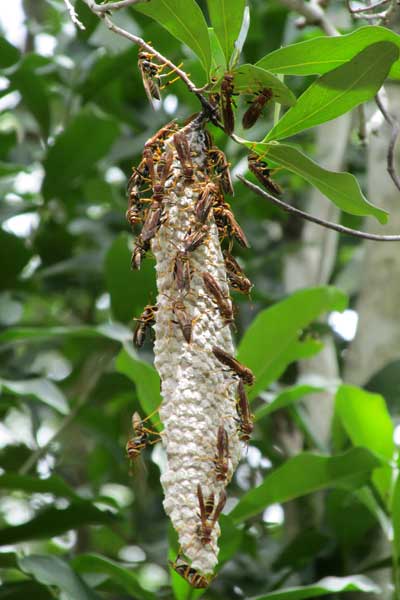
The above picture mainly shows one face of the nest. A distinguishing feature of the nest's form is shown when viewed from its side, seen below:

The nest diminishes in thickness from top to bottom. This has been noted on all the nests of this species I've seen.
Most of the time this nest is in the shade, but when a shaft of sunlight hits it, wasps rush into the light and begin fanning. Apparently the cells' brooding larvae are vulnerable to overheating. Below, you can see a close-up of wasps ventilating with their wings the brood cells beneath them:
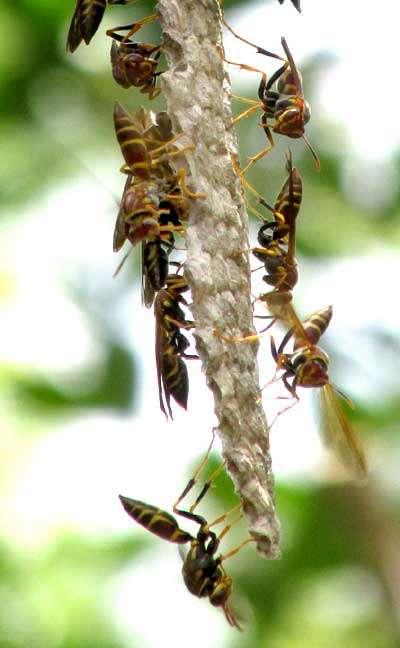
A close-up of a single wasp, her wings a blur as she fans cells below her, is shown below:
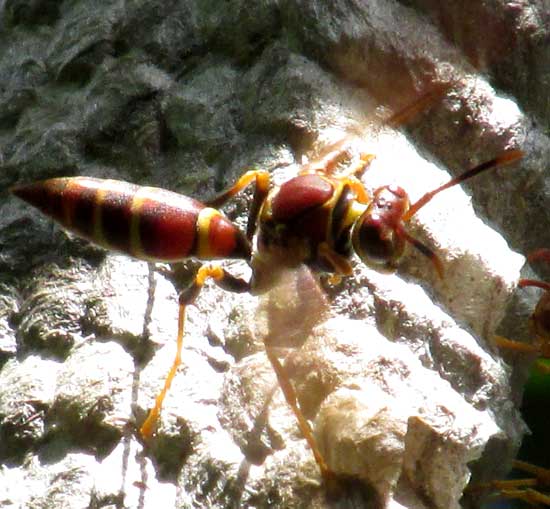
The Wasp "Superfamily" embracing everything from paper wasps and hornets to potter and pollen wasps, the Vespoidea, is a vast one, with the often-hard-to-identify species producing a wide range of nests. You might enjoy our wasp page providing an overview of the most commonly noticed wasp families at www.backyardnature.net/wasps.htm
I had trouble identifing these wasps, and now have their name only because wasp enthusiast Terry Prouty, who collects large wasp nests -- see his Facebook Wasp Group -- identified them as POLISTES INSTABILIS.
The Maya workers here tell me that these wasps are bad stingers, though I've never had trouble with them as I pass right below them several times each day. Also I'm told that this is one species of which no one bothers to eat the larvae roasted inside their chambers, as happens with some other paper-wasp species.
from the September 24, 2017 Newsletter issued from Rancho Regenesis in the woods ±4kms west of Ek Balam Ruins; elevation ~40m (~130 ft), N20.876°, W88.170°; north-central Yucatán, MÉXICO
PAPER WASP NEST LOOKING OMINOUS
In our earlier look at this wasp, the nest seemed like something I could live with. But look at now, below:
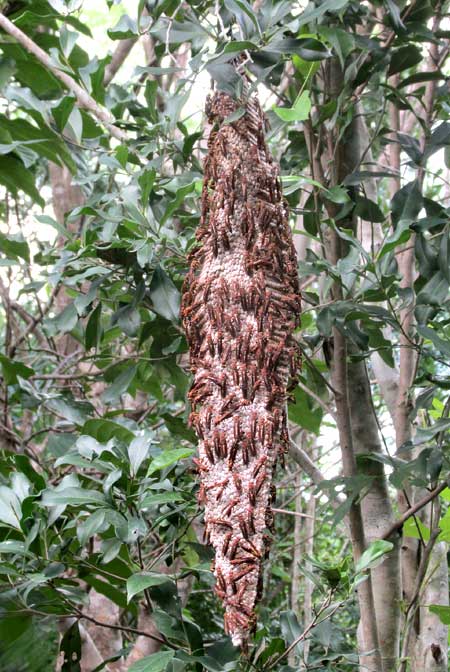
The nest is very much larger bearing very many more wasps than before, and is much heavier so that it dangles much lower. So far when my bald head passes below they don't seem the least concerned. However, up North as fall approaches, I've seen paper wasps who have been peaceful all summer turn irascible as the days got shorter, the nights cooler, and winter approaches -- when the wasp sisters die.
Here there's much less difference in day length between summer and winter, and it doesn't get cold enough to kill wasps, though the dry season will come in November or so. I just don't know what will happen with these wasps...
from the October 1, 2017 Newsletter issued from Rancho Regenesis in the woods ±4kms west of Ek Balam Ruins; elevation ~40m (~130 ft), N20.876°, W88.170°; north-central Yucatán, MÉXICO
PAPER WASP NEST UPDATE
This week the nest got so heavy that it lowered until it was less than a foot above my bald head. Despite the wasps having never attacked me, I figured I'd better do something before they did.
I found a pole about 20ft long, forking at the top. One morning right before the sun rose, but when there was already enough light to see, I lifted the branch holding the nest, and secured the pole in place beneath it. Now the nest's bottom resides about six feet above my head, and I feel safe passing beneath it.
For the first hour after the nest was raised, several wasps circled in empty space where the nest had been. They did that until they got tired, then gathered on the branch nearest the nest's former location.
Two hours later, wasps still circled where the nest had been, but now they'd learned to explore upward, until the nest was found. The wasps displayed an uncanny sense of where the nest "should" be, but couldn't identify the nest in plain view just a few feet above. After about six hours, most wasps had adjusted to the new location, and life continued as before.
While the nest had dangled so low, I noticed that throughout the day wasps arrived from the woods carrying small balls of something yellowish. With the nest so low, I could take the interesting photo shown below:
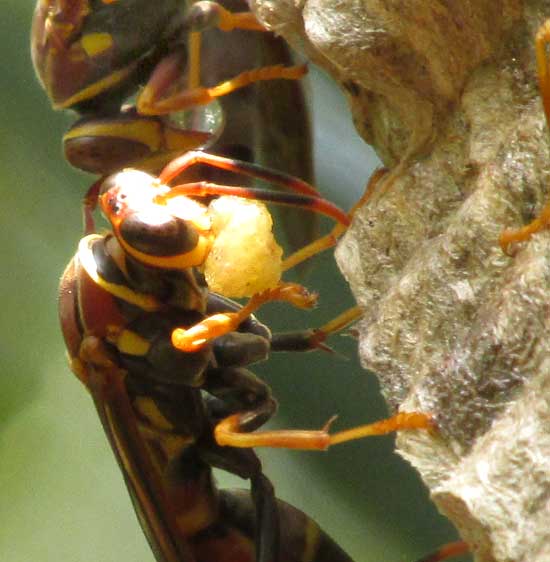
That picture shows the heads of two wasps, both holding yellow balls in their mandibles. The picture makes sense when we read that the species is suspected to prey on arthropod larvae. I write "suspected," because studies haven't been published yet. We may be providing useful information and pictures here for a future researcher.
I'm guessing that the yellow balls are "meatballs" consisting of compacted caterpillar sections. I'm further guessing, especially because of their size, that the meatballs are to be inserted into the nest's cells, where they'll be eaten by developing wasp larvae. Judging from the number of wasps arriving at the nest carrying these balls, the wasps must be affecting the caterpillar population on nearby trees. Since the caterpillars probably are eating the trees' leaves, this wasp nest may be of great service to the forest surrounding it.
And the nest will grow heavier and heavier, so probably this story isn't finished yet.
from the October 22, 2017 Newsletter issued from Rancho Regenesis in the woods ±4kms west of Ek Balam Ruins; elevation ~40m (~130 ft), N20.876°, W88.170°; north-central Yucatán, MÉXICO
LAST PAPER WASP NEST UPDATE
After my two weeks of traveling, when I returned to the hut the first item I checked was the status of our wasps. The big paper nest hung where it was supposed to be, but all the wasps were gone. Not a single one circled around the nest. When my Maya-worker friend Gener came for a visit I asked if he knew what had happened to them. "Hormigas," he said. "Ants."
Gener had watached as the big, black wave of thousands of black ants washed across the landscape. They'd entered my hut, found, dismembered and carried away spiders and scorpions in the hut's thatch, and they'd climbed each tree around the hut, including the wasp-nest tree. Discovering our wasps' nest, they'd swarmed over it, cut open the cells and plundered the wasps' precious larvae and pupae.
At www.backyardnature.net/mexnat/waspmex.htm, about halfway down the page, you can review a dramatic attack ants made on a paper-wasp nest dangling on my hut's thatch roof a while back at Chichén Itzá. Both then and now the wasp-nest-destroying ants were army ants, about whom we have a great deal to say and show at www.backyardnature.net/mexnat/armyant.htm
The smaller wasp nest I've mentioned hidden in bushes beside the hut's exit also is depopulated. Now I understand better why the hut's roof bears quite a number of abandoned paper-wasp nests, and why the nest I've enjoyed so much watching lately was placed in such an out-of-way spot as the very tip of a long, slender branch that eventually dipped too low for comfort.
Earlier, as I watched our wasps during their most robust building period, the impression had been that the nest just couldn't have been better protected and safe. But, never forget the ants. At least in the tropics, ants very often hold the trump card in any game of survival.